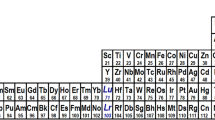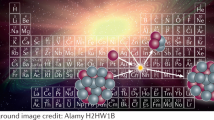Abstract
Some recent work in mathematical chemistry is discussed. It is claimed that quantum mechanics does not provide a conclusive means of classifying certain elements like hydrogen and helium into their appropriate groups. An alternative approach using atomic number triads is proposed and the validity of this approach is defended in the light of some predictions made via an information theoretic approach that suggests a connection between nuclear structure and electronic structure of atoms.




Similar content being viewed by others
Notes
Several journals are devoted to the field of mathematical chemistry including, MATCH Communications in Mathematical and in Computer Chemistry, published since 1975 and Journal of Mathematical Chemistry published since 1987.
In addition many other branches of chemistry have been studied using these and other mathematical approaches which are not physical theories.
The rule was first discovered by C. Janet for reasons quite independent of quantum mechanics (Stewart 2010).
What is intended here by ‘elements’ is elements as abstract or basic substances as they have been termed by Paneth. For example, the ‘element’ sodium is the abstract element that underlies both sodium as a simple uncombined substance and also sodium as it occurs when combined in sodium chloride for example. There is an already large literature in contemporary philosophy of chemistry which seeks to clarify this notion of element as basic or abstract substance (Hendry 2005; Earley 2009; Ruthenberg 2009; Scerri 2008c).
See p. 245 especially.
The term secondary is being used here not in the sense of being less fundamental than primary classification but simply to mean a classification that depends upon assuming and building further upon the primary classification. One may think of an analogy with primary, secondary and tertiary structure in protein chains.
See pp. 165–175.
Nevertheless, some of Mendeleev’s early tables were actually of a long-form.
There is little doubt that even if Mendeleev tried to distance himself from numerological aspects of using triads, his reasoning when making predictions about yet undiscovered elements lay precisely in the use of the concept of triads, sometimes even using triads in two directions. See Scerri 2007, p. 135.
There is a sense in which the periodic table of the ‘elements’ has been replaced by the periodic table of the neutral gas-phase atoms.
In the case of hydrogen a half-filled shell represents one of a possible two electrons, while carbon has four out of a possible eight outer-shell electrons.
This can also be achieved using a conventional or medium-long form display but matters are not so clear. Because of the peculiarities of placing the s-block elements at the left of the medium-long format, perfect triads involving s-block elements require that the first and second elements should be in periods of equal lengths.
This is true of the conventional medium-long form table but not the left-step format.
This point will be taken up again shortly.
Some authors object to this proposal and claim that H and He do not belong to triads in principle (Bent 2006).
The placement of H among the halogens has been proposed by many authors for a variety of chemical reasons such as the fact that hydrogen forms a singly-charged negative ion as do the halogens and the fact that hydrogen occurs as a diatomic molecule H2 as do all the halogens.
Yttrium (39), lutetium (71) and lawrencium (103), form a perfect atomic number triad, whereas yttrium (39), lanthanum (57), and actinium (89) do not.
For a critique of Lavelle’s resistance see Scerri 2009.
Such an objection was made by Eugen Schwarz at the 2008 ISPC meeting in Coburg, Germany.
Triads may be regarded as ‘local’ in the literal sense of referring to a region of elements lying adjacent to each other in the periodic table. But here I am using ‘global’ to mean that the triads concern a relationship between different elements and so capture the key aspect of chemical periodicity.
Some of the philosophers who have written on this topic were listed above.
At a conference in Leuven, Belgium, Robin Hendry objected to this notion and expressed the view that the nucleus does indeed govern the motion of electrons in the sense of energetic terms such as Coulombic attraction. But this is not what I am getting at. Of course it is trivially the case that electronic motion in atoms and molecules is mathematically governed by the nucleus. My claim is that it is not usually believed that nuclear ‘structure’, per se, causes a particular electronic configuration to be adopted in any particular atom.
This comes about by simplifying the electronic configuration of chromium, namely, 1s 2, 2s 2, 2p 6, 3s 2, 3p 6, 3d 5, 4s 1 and vanadium, which is taken to be 1s 2, 2s 2, 2p 6, 3s 2, 3p 6, 3d 3, 4s 2.
The terms containing 2 and 8 cancel and have therefore been omitted.
The predictions were actually made on 45 isotopes but four of these could not be verified as they had not yet been synthesized. See table for details.
The governing physical theory could still be quantum mechanics although now applied to the study of the nucleus. However, early hints of this might come in the form of purely mathematical approaches such as Bonchev’s use of information theory.
References
Atkins, P.W., Kaesz, H.: The placement of hydrogen in the periodic table. Chem. Int. 25, 14 (2003)
Bensaude-Vincent, B.: Mendeleev’s periodic system of chemical elements. Br. J. Hist. Sci. 19, 3–17 (1986)
Bent, H.A.: New Ideas in Chemistry from Fresh Energy for the Periodic Law. Author House, Bloomington (2006)
Bent, H.A., Weinhold, F.: News from the periodic table: an introduction to periodicity symbols, tables, and models for higher-order valency and donor–acceptor kinships. J. Chem. Educ. 84, 1145–1146 (2007)
Bogaard, P.A.: The limitations of physics as a chemical reducing agent. Proc. Philos. Sci. Assoc., (PSA 1978) 2, 345–356 (1978)
Bonchev, D.: Periodicity of the chemical elements and nuclides: an information-theoretic analysis. In: Rouvray, D.H., King, R.B. (eds.) The Mathematics of the Periodic Table, pp. 161–188. Nova Science Publishers, New York (2006)
Carbo-Dorca, R.D.: On the extension of quantum similarity to atomic nuclei. J. Math. Chem. 23, 327–351 (1998)
Carbo-Dorca, R.D.: General trends in atomic and nuclear quantum similarity measures. Int. J. Quantum Chem. 77, 685–692 (2000)
Clark, R.W., White, G.D.: The flyleaf periodic table. J. Chem. Educ. 85, 497 (2008)
Cronyn, M.W.: The proper place for hydrogen in the periodic table. J. Chem. Educ. 80, 947–951 (2003)
Döbereiner, J.: Versuch zu einer gruppirung der elementaren stoffe nach ihrer analogie. Poggendorf’s Ann. Phys. Chem. (Leipzig) 15, 301–307 (1829)
Earley, J.: Why there is no salt in the sea. Found. Chem. 7, 85–102 (2005)
Earley, J.: How chemistry shifts horizons: element, substance, and the essential. Found. Chem. 11, 67–77 (2009)
Goeppert Mayer, M., Jensen, H.: Elementary Theory of Nuclear Shell Structure. Wiley, New York (1955)
Hendry, R.F.: Lavoisier and Mendeleev on the elements. Found. Chem. 7, 31–48 (2005)
Hendry, R.F.: Entry for “chemistry”. In: Psillos, S., Curd, M. (eds.) The Routledge Companion to Philosophy of Science, pp. 520–530. Routledge, London (2008)
Ibrahim, S.A.: Predicting the atomic weights of the trans-lawrencium elements: a novel application of Dobereiner’s triads. J. Chem. Educ. 82, 1658–1659 (2005)
Janet, C.: La Classification hélicoïdale des éléments chimiques. Imprimerie Départmentale de l’Oise, Bauvais (1928)
Jensen, W.B.: The positions of lanthanum (actinium) and lutetium (lawrencium) in the periodic table. J. Chem. Educ. 59, 634–636 (1982)
Kibler, M.: The periodic system of chemical elements, old and new perspectives. J. Chem. Struct. (Theochem) 187, 83–93 (1989)
Kibler, M.: From the Mendeleev table to particle physics and back. Found. Chem. 11, 221–234 (2007)
Laing, M.: Where to put hydrogen in a periodic table? Found. Chem. 9, 127–137 (2007)
Lakatos, I.: The Methodology of Scientific Research Programmes: vol. 1, Philosophical Papers. In: Worrall, J., Currie, G. (eds.), pp. 43, 53–55, 118–119, 223. Cambridge University Press, Cambridge (1980)
Lavelle, L.: Lanthanum (La) and actinium (Ac) should remain in the d-block. J. Chem. Educ. 85, 1482–1483 (2008)
Montgomery, J.P.: Dobereiner’s triads and atomic numbers. J. Chem. Educ. 8, 162 (1931)
Novaro, O.: Comments on the group theoretical justification of the aufbau scheme. Int. J. Quantum Chem. (Symposium) 7, 23–33 (1973)
Ostrovsky, V.: On recent discussion concerning quantum justification of the periodic table of the elements. Found. Chem. 7, 235–239 (2005)
Ramsey, J.: Chemistry. In: Pfeifer, J., Sarkar, S. (eds.) Philosophy of Science, an Encyclopedia. Routledge, London (2006)
Restrepo, G., Pachón, L.: Mathematical aspects of the periodic law. Found. Chem. 9, 189–214 (2007)
Rouseva, B., Bonchev, D.: Prediction of the nuclear binding energies of the nuclides of period VII. Radiochem. Radioanal. Lett. 45, 341–346 (1980)
Ruthenberg, K.: Paneth, Kant and the philosophy of chemistry. Found. Chem. 11, 65–77 (2009)
Sacks, L.: Concerning the position of hydrogen in the periodic table. Found. Chem. 8, 31–35 (2006)
Scerri, E.R.: Has chemistry been approximately reduced to quantum mechanics. Proc. Philos. Sci. Assoc. (PSA), Hull, D., Forbes, M., Burian, R. (eds.), 160–170 (1994)
Scerri, E.R.: The Periodic Table, Its Story and Its Significance. Oxford University Press, New York (2007)
Scerri, E.R.: The Role of triads in the evolution of the periodic system. J. Chem. Educ. 85, 585–589 (2008a)
Scerri, E.R.: The past and future of the periodic table. Am. Sci. 96, 52–58 (2008b)
Scerri, E.R.: The dual sense of the term ‘element’, attempts to derive the Madelung rule, and the optimal form of the periodic table, if any. Int. J. Quantum Chem. 109, 959–971 (2008c)
Scerri, E.R.: Which elements belong in group 3? J. Chem. Educ. 86, 1188 (2009)
Scerri, E.R., Kreinovich, V., Wojciechowski, P., Yager, R.R.: Ordinal explanation of the periodic system of chemical elements. Int. J. Uncertain. Fuzziness Knowl. Based Syst. 6, 387–400 (1998)
Schwarz, W.H.E.: Recommended questions on the road towards a scientific explanation of the periodic system of chemical elements with the help of the concepts of quantum physics. Found. Chem. 9, 139–188 (2007)
Schwarz, W.H.E.: Review of Eric Scerri, the periodic system, its story and its significance. Angew. Chem. Int. Ed. 48, 3391–3392 (2009)
Service, R.: Does life’s handedness come from within? Science 286, 1282–1283 (1999)
Shannon, C.E.: A mathematical theory of communication. Bell Syst. Tech. J. 27, 379–423 (1948). (623–656)
Shapere, D.: Scientific theories and their domains. In: Suppe, F. (ed.) The Structure of Scientific Theories, pp. 518–599. Illinois University Press, Chicago (1974)
Sneath, P.H.A.: Numerical classification of the elements and its relation to the periodic system. Found. Chem. 2(3), 237–263 (2000)
Stewart, P.: Charles Janet: unrecognized genius of the periodic table. Found. Chem. 12 (2010). doi:10.1007/s10698-008-9062-5
Weisberg, M.: Who is a modeler? Br. J. Philos. Sci. 58, 207–233 (2007)
Acknowledgment
The author thanks reviewers for the careful reading of this paper and for many useful suggestions.
Author information
Authors and Affiliations
Corresponding author
Rights and permissions
About this article
Cite this article
Scerri, E. Explaining the periodic table, and the role of chemical triads. Found Chem 12, 69–83 (2010). https://doi.org/10.1007/s10698-010-9082-9
Published:
Issue Date:
DOI: https://doi.org/10.1007/s10698-010-9082-9




